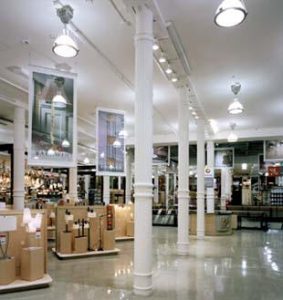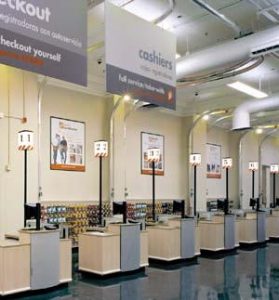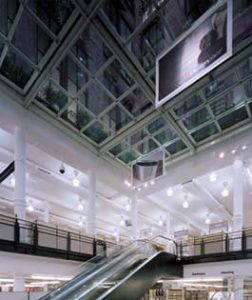For Manhattanites, do-it-yourself has always been more do-yourself-in.
Merely installing a high-end overhead lighting fixture requires superior fortitude to handle the hassle of a snooty showroom, a four-to-six-week wait for delivery, a grimy hardware store to buy the necessary tools and screws to install it and hiring an expensive handyman/ electrician (who hopefully owns the tall ladder that most apartments can’t afford the space to store). Then, when the bulbs inevitably burn out, comes the sleuthing for those specialty light bulbs that nobody seems to carry.
No wonder the locals are greeting the new Home Depot on West 23rd Street as a one-stop-shopping prayer answered.
In September, the country’s largest home-improvement retailer broke its own mold by bringing its orange box of tricks to the frustrated masses. Taking up residence in an 1878 cast iron gem, the original Stern Brothers Department Store (most recently the Hasbro toy company headquarters), required a focus-group re-examination of every aspect of how Home Depot merchandises and space- prioritizes departments for this new, notoriously demanding, consumer base. (Before the end of the year, another 110,000-square-foot store will open in the Cesar Pelli-designed Bloomberg Tower at Lexington and 58th.)
As a result, this Home Depot offers much of what its ritzier corporate sibling, the Expo Design Center stores, supply, but with a cosmopolitan twist – skewing to smaller scale, more contemporary fixtures and luxe appliances. On the quiet mezzanine, one can check out sample kitchen and bathroom installations that start at prices so reasonable that even those holding onto a rent-controlled apartment might consider. The product range extends on up to Italian glass tile and regal waterfall bathtubs. No-fee staff interior designers will come up with plans and an associated company will make sure the apartment building’s structure can actually support the fantasy. And if the delivery requires a crane, they handle all the aggravation.
Other Manhattanite-pleasing touches include: doormen that can help the overburdened lumber to a cab, a 24-hour locksmith, pickup and delivery of power tools and local-interest clinics like feng shui and gardening on fire escapes.
Advertisement
It’s also a pleasant shopping environment that exploits its urban setting rather than fighting with it. Though this is the chain’s newest store, it’s in its oldest building. As James Bry, project manager/associate with Greenberg Farrow Architecture (New York), says, “We used the historic character of the building as a design departure point.” The 105,000-square-foot store presents a welcoming façade to the street, with rotating window displays, a departure from its customary inward-looking plan. Inside, the interior columns are original though the mezzanine’s walls were removed to improve the sightlines. The ground floor is composed of 120,000 pounds of neutral California sand that has been coated with a clear polymer polished to a high shine. To the right of the entrance, area rugs are displayed on an 800-pound motorized rack, nicknamed “the spider” for its multiple legs. To the left are over 1000 lighting fixtures, near more than 400 varieties of lightbulbs.
Because the store is vertical, there are Vermaports alongside the escalators to take shopping carts between the levels. In the center of the store, above the concierge desk, one can glance up into a European-looking, multistory, skylit atrium. Windows festooned with red canopies and flower boxes trailing greenery only enhance the impression that Manhattanites have happened upon a portal into an alternate shopping universe, where everything just got a lot easier.
Client: Home Depot, Atlanta
Bob Nardelli, president, ceo
Architect/Design: Greenberg Farrow Architecture, New York
John Clifford, principal-in-charge
Navid Maqami, vp, architecture
James Bry, project manager/associate
Xiony Gomex, project architect
Anthony Kender
Melissa Hon
Outside Design Consultants: Howard Rosen Associates, New York (mechanical, electrical and plumbing)
U:Lighting, New York (lighting)
General Contractor: IBEX Construction, New York
Advertisement
Flooring: Brominite, New York
Lighting: Cooper Lighting, Atlanta
Photography: ®Paul Rivera/archphoto, New York
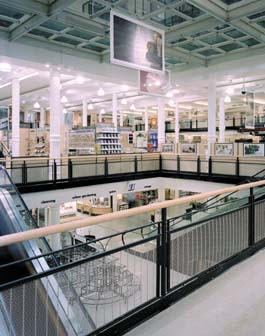

 Headlines1 week ago
Headlines1 week ago
 Headlines2 weeks ago
Headlines2 weeks ago
 Headlines2 weeks ago
Headlines2 weeks ago
 Headlines3 days ago
Headlines3 days ago
 Headlines4 days ago
Headlines4 days ago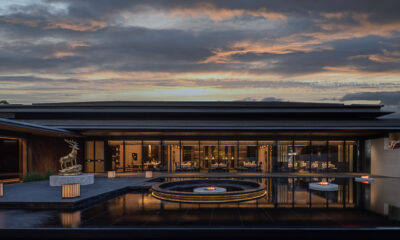
 Design Detail3 days ago
Design Detail3 days ago
 Headlines1 week ago
Headlines1 week ago
 Headlines2 weeks ago
Headlines2 weeks ago

